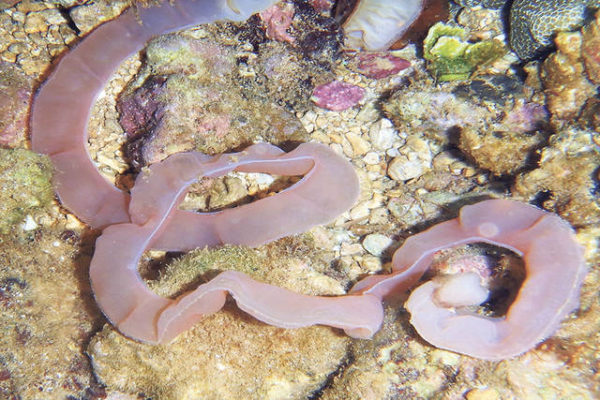Published in the Ocean Watch column, Honolulu Star-Advertiser © Susan Scott
September 22, 2018
A few weeks ago, I wrote that while snorkeling I found the red gonads of a sea cucumber, cast out when something threatened the animal. In addition to causing the sea cucumber to disgorge its guts, the disturbance had also somehow exposed an intact acorn worm about 2 feet long.
I say somehow because we rarely see acorn worms out in the open. The fragile, soft-bodied creatures’ only defense against predators such as cone and auger snails is to stay out of sight.
 Most acorn worms live in u-shaped burrows under sand or mud,
Most acorn worms live in u-shaped burrows under sand or mud,
sucking the surrounding substance into their mouths.
©2018 Susan Scott
Most acorn worms live in u-shaped burrows under sand or mud, sucking the surrounding substance into their mouths. After digesting mixed-in organic matter, the worm deposits clean grit on the ocean floor in squiggly piles.
The mounds, called fecal casts, are often mistaken for feces, but for material that comes out of a marine animal’s anus, it’s pretty clean stuff. The piles often appear darker than the white sand they rest on because the worm has burrowed into mud below.
Kaneohe Bay’s sand bar is a good place to see dozens, sometimes hundreds, of acorn worm castings. Don’t worry. Those piles aren’t poo.
Acorn worms get their name from their muscular, burrowing heads that resemble acorns. The skin of their bodies trailing behind is so thin that if you dig one up, the weight of the sand or mud inside can easily tear open the body wall, which kills the creature.
I have read about, and admired, acorn worms for years, but not wanting to harm one, had merely seen their casts. Only after Dr. Julie Bailey-Brock of the University of Hawaii WormLab identified it in my photo, did I know that I’d seen my first acorn worm in the flesh.
I was thrilled to have made its acquaintance, but how it came to be lying out in the open, empty of sand, is a mystery. My best guess as to what happened was that the sea floor had been disturbed by octopus hunters who frequent the area.
I don’t fish for octopuses but the internet showed me how it goes. The fisher snorkels or walks a shallow reef armed with a spear, or stick and a sack. The skilled part is spotting a hiding octopus. The fisher gently inserts the stick tip into the hole and lets the curious octopus crawl onto it. Then, wham, into the sack.
I thought that maybe during this process, someone had stepped on the sea cucumber. But why the acorn worm was lying next to it, I do not know.
Regarding my column about sea cucumber innards, a reader wrote, “Funny, I just saw a Japanese TV program about dried sea cucumber ovaries as a delicacy. They are red and pretty large when sliced open and spread out (hanging) to dry. They look kind of crunchy.”
Years ago, I learned about the intelligent behaviors of octopuses, and stopped eating them. But sea cucumber gonads? Well, maybe.